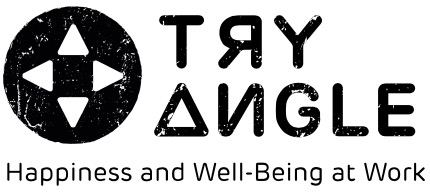The concept of the four-day working week (performing 32 hours on four days in exchange for 5 days’ pay) is attracting increasing attention. Pilot projects in many countries and organisations are showing impressive results and positive effects.
Tryangle also switched to the real four-day working week from 1 September 2023 – and not the one from the Belgian labour deal. We received a lot of reactions to this announcement, including many questions, so we don’t want to withhold the answers to these questions and additional insights from the readers of our happinessatwork blog:
Questions addressed in this blog:
The war for talent: Isn’t this making the problem bigger?
Is there a link to the exaggerated drive for worklife balance of the youngest generations?
How do you know work won’t be left unfinished?
Isn’t more office presence required for this concept to succeed?
Won’t you go bankrupt like this?
Does one have to be super efficient 8 hours a day?
Extra: What we observed
The war for talent
Question: “There is currently a pressing scarcity in the labour market. Aren’t you compounding the problem by deploying the limited talent available just fewer hours per week?”
Griet Deca: It is indeed a fact that talent is scarce. However, there is a fallacy when you only look at the “fewer hours per week” aspect. Research shows that productivity increases to at least a stabilisation of work performance in the old system, and there can even be a +100% effect due to the positive spillover , leading to even higher productivity for employees and thus more turnover for the organisation.
The clear appreciation of employees by choosing more wellbeing and work happiness, strengthens employer branding and increases the attractiveness of organisations which will just make it easier to attract and retain talent, a strong asset in the war for talent.
Above all, let’s not forget that the labour market is in perpetual flux. Today’s talent scarcity will not last either – companies should prepare today for the future (in which the pendulum will undoubtedly swing the other way again). In a future world where the power of the labour market will undoubtedly once again be up to companies in terms of recruitment, the real four-day week could become a decisive Employee Value Proposition.
The excessive drive for worklife balance
Question: “The youngest generations no longer want to work full-time but at the same time dream of a life of luxury full of travel, hobbies and self-development. To what extent then has the pendulum not swung and are they building castles in the air? There has to be bread on the table, right?
Kim Hilgert: Above all, let us remain nuanced and not make generalised assumptions. Gen Z’ers do not necessarily want to work less hard or do less work than other generations, they just have a different idea of what hard work means. Above all, Gen Z has understood very well that they were born to live. Working to live life to the full is obvious to them. Living to work absolutely not. Unlike the classic switchback to a 4/5 work regime, the real four-day week is not sick in the bed of “less pay for the same work”.
With the real four-day work week, you receive the same pay for the same work output where you work with your employer to find out how this can be achieved. Companies making the switch today do so out of a genuine concern for the well-being of their employees. At Tryangle, it is no different. We had extensive discussions with our employees and jointly decided to recruit additional helping hands to ensure that we could continue to achieve at least the same output. The first period shows that we are currently realising much more than before.
Work that is left undone
Question: “One of the pilot cases showed that more people were hired. Is this then still a signal that work performance sometimes does not get to the 100% level with the 80% commitment? And doesn’t this then lead to potentially higher wage costs due to hiring additional staff?”
Kim Hilgert: Above all, the real four-day week should not become a poisoned gift and create more stress on those 4 days because the workload can no longer be managed well. Importantly, as an employer, you only take this step if you are truly willing to invest in the well-being of your staff.
This investment can therefore also mean that extra people will be hired, which is inherent to successful companies. At Tryangle, we want to give people work as an employer. For us, this is a very conscious choice and also inherent to a scale-up in full growth. The various pilot projects in different countries show that this choice of extra manpower is not a sine qua non.
At Tryangle, we proactively sought reinforcement. The first conclusions from the pilot projects show above all that working fewer hours does not automatically mean hiring more staff. Above all, it is an opportunity for optimisation (such as using AI) and looking together for the most efficient way of working. The “cut the crap” way of working, more people-oriented leadership and steering by output instead of presence offer a lot of opportunities in this context. When teams think about this together and, for example, hold fewer (unnecessary) meetings, lose less time on non-relevant tasks (so being able to distinguish between main and secondary issues), lose less time on travelling when digital/virtual contact is sufficient,… it is absolutely possible to achieve the same performance with the same team and with fewer hours.
More attendance at the office
Question: “Reports from 4 Day Week Global pilot projects reveal that less remote work would happen. The idea behind this is that people simply need to get together to clear up misunderstandings and ensure smooth collaboration. Doesn’t it then mean that it is best to all be in the office together anyway if the four-day work week is to succeed?”
Griet Deca: The four-day work week indeed sharpens the challenge of working together more efficiently, communicating more strongly and making the right arrangements. So teams need to be well aligned, but that is more a plea for maturity, responsibility, a speak-up culture, stronger consultation and better connection than a plea for office presence.
Efficiency can be found in both pillars of the hybrid context, depending on the business setting, tasks (vb focus tasks versus creative tasks) and employee preferences. But the success rate does not lie in choosing either remote/home work OR office work nor is there one golden formula that is going to work everywhere.
After all, even in a completely remote context, inefficient zoom meetings can take place. And even within a fully in-office team, misunderstandings and delays can occur. No matter what choice is made within the organisation or team about hybrid composition, it is always about eliminating the drawbacks and maximising the benefits. The four-day working week can be an additional catalyst to succeed in this to find best of both worlds. In whatever hourly regime you work, connectedness with each other and your employer has become a crucial factor, especially in a hybrid or remote reality. So you need to give that enough attention anyway.
Bankruptcy in the making?
Question: “Aren’t you going to go bankrupt like this?”
Griet Deca: Reptile or stress brains don’t speak any louder! Fear is a very bad counsellor, especially for an entrepreneur. Of course, it is important not to force this kind of transformation overnight, but to get started in a well-considered way. It involved a lot of calculation and analysis. There were sincere discussions, both with the employees and between the business managers.
The fact is: our profit margin is going down, but thanks to our expertise and the fact that we are surrounded by the right experts, we know that this will be far from problematic. Au contraire: the lower profit figures today will translate into higher energy figures from our employees. Because we as business managers take good care of them, they take even better care of our customers. Not surprisingly, previous experiments in England, for example, show how participating companies report higher customer satisfaction scores. Those figures, in turn, translate into more cross- and up-selling. The lower profit figures at the start thus become quite relative, of course.
Being efficient 8 hours a day
Question: “I recently read about a plea that employers cannot expect employees to be productive 8h a day. The working day should then also include time to take breaks or have non-work-related conversations with colleagues for connection, for example. It is already a challenge to get employers to grasp this for a 40h working week, how are you supposed to cram this into a 32h story?”
Kim Hilgert: Right! This is precisely why we are not fans of the Belgian variant in which employees can opt for a four-day working week with longer working days. A system in which everyone loses because our human brain already bumps up against its limits at 8 hours of work a day.
Just because people have more time to de-connect and recharge their batteries, we see less time spent on the shop floor on the “extra professional”. Of course, genuine human interest in each other remains and we continue to inquire about each other’s weekends and the like, but thanks to better-charged batteries thanks to more free time, we see less time flowing into that.
Extra: What we have observed
Griet Deca: A less measurable qualitative aspect linked to the four-day work week, but a topic around which we feel a very positive impact revolves around the theme of innovation and creativity.
The combination of a motivating, positive company culture AND the work-life balance that 1 day more free time per week brings a side effect to the surface that is linked to how the human brain works. Because the extra time for relaxation, mind wandering and brain care leads to a lot of bubbling inspiration, creativity and appetite in the form of ideas for the work context that get space to surface while you are walking or gardening.
Still have unanswered questions?
Do you still have questions for our co-founders about our decision or approach to the four-day work week?
Do not hesitate to contact us, we will definitely provide an answer!
Know more?
Want to know more about our announcement and the drivers behind our switch to this new system? You can read the article here.





